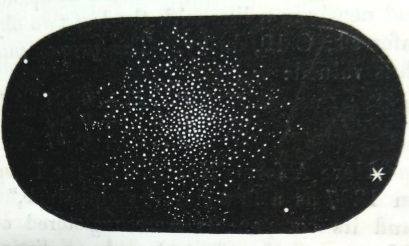A Cycle of Celestial Objects by Admiral William H. SmythのM13
2014年9月 日本語訳 舟越 和己
1115. 13 M. HERCULIS. DLXXXV.
A large cluster, or rather ball of stars, on the left buttock of Hercules, betweenζ andη ; fromη
Herculis it lies S., a little westerly, and 3°1/2 distant. This superb object blazes up in the centre,
and has numerous outliers around its attenuated disc. [Secchi found a field 8' in diameter filled
with stars.] This object was accidentally hit upon by Halley, who says, " This is but a little patch, b
ut it shows itself to the naked when the sky is and the moon absent."
The same paper, in describing this as the sixth and last of the nebulae known in 1716, wisely admits
that "there are undoubtedly more of these which have not yet come to our knowledge:" ere half
a century had passed, Messier contributed his 80 or 90 in the Catalogue of 103; and before the
close of that century Hershel alone had added to the above 6, no fewer than 2500 ; and his son,
in re-examining these, added 520 more !

In my refractor its appearance was something like the annexed diagram; but I agree with Dr. Nichol,
that no plate can give a fitting representation of this magnificent cluster. It is indeed truly glorious,
and enlarges on the eye by studious gazing. " Perhaps/' adds the Doctor, " no one ever saw it for
the first time through a telescope without uttering a shout of wonder."
This brilliant cluster was discovered by Halley in 1714; and 50 years afterwards it was examined
by Messier, with his 4 ft Newtonian, under a power of 60, and described as round, beautiful, and
brilliant ; but, " ferret " as he was in these matters, he adds, " Je me suis assurÉ qu'elle ne contient
aucune etoile."
This is rather startling, since the slightest optical aid enables the eye to resolve it into an extensive
and magnificent mass of stars, with the most compressed part densely compacted and wedged
together under unknown laws of aggregation. In 1787, Sir W. Herschel pronounced it "a most
beautiful cluster of stars, exceedingly compressed in the middle, and very rich.'* In the Earl of
Rosse's telescope the components were more distinctly separated, and brighter, than had been
anticipated; and there were singular fringed appendages to the globular figure, branching out into
the surrounding so as to form distinct marks among the general outliers.
【日本語訳】 ヘルクレス座のM13
ヘルクレス座のζ 星とη星の間、ヘルクレスの臀部にある星の大集団、もっと正確に言えば球状の星
の集団;それはη星から南(少し西)の方向に3°1/2離れた位置にあります。この素晴らしい天体は中心
が輝き、光が弱まったディスクの周辺に(中心から離れた)多数の星々があります。[Secchiは星で満たさ
れた直径を8'としました]
この天体はハレーにより偶然見つけられました。ハレーは「これは小さな滲みだが、月のない夜に肉眼でも
見ることができる」と言いました。1716年に知られていた6つの星雲の最後としてこれが記述されていた論文
において、ハレーは「そこには我々の知識がまだ到達し得ないもの以上のものが間違いなく存在する」という
ことを賢明にも認めました。
やがて半世紀が過ぎ、メシエは彼の80年又は90年の生涯を103のカタログに捧げました;そして18世紀の
終り頃にハーシェルは(ハレーの頃の)上記の6つの星雲に2500も追加しました;そして彼の息子はこれらを
再検討して520以上を追加しました!

私の屈折望遠鏡ではその姿は付図(上図)に似ていますが、「どんな図版もこの素晴らしい星の集団を
適切に表現できません。それは実際、本当に素晴らしい。おそらく、それを望遠鏡で始めて見る人は皆、
驚嘆の叫びを上げるでしょう。」というNichol博士の言葉に同意します。
この輝かしい星団は1714年にハレーにより発見され、50年後に(焦点距離)4フィート60倍のニュートン
でメシエにより確認され、丸くて美しく輝いていると記述されました;しかし、メシエはこれらのことに関し
て「探索者」でしたが、「その天体にはいかなる星も含まれていないことを確信します。」と付け加えま
した。これはむしろ驚くべきです。ちょっとした光学的補助(小口径)で、集団の知られざる法則による
きめ細かい密集した素晴らしい星の集団に分解することができます。1787年に、ウィリアム・ハーシェル
卿は、「中央が密集した鮮やかで最も美しい星団」と述べました。最近、それはロス伯の新しい強力な
望遠鏡で観察され、期待した以上に明るく、はっきりと分離されました;球状の本体の周辺の特異な
付属物が一般的な外れ値を識別するマークを形成するように周囲の空間に枝を伸ばしています。